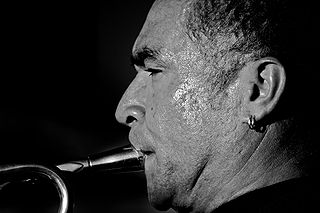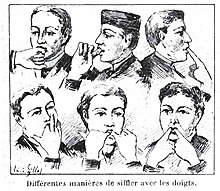
Embouchure or lipping is the use of the lips, facial muscles, tongue, and teeth in playing a wind instrument. This includes shaping the lips to the mouthpiece of a woodwind instrument or the mouthpiece of a brass instrument. The word is of French origin and is related to the root bouche, 'mouth'. Proper embouchure allows instrumentalists to play their instrument at its full range with a full, clear tone and without strain or damage to their muscles.

The tin whistle, also called the penny whistle, is a simple six-holed woodwind instrument. It is a type of fipple flute, putting it in the same class as the recorder, Native American flute, and other woodwind instruments that meet such criteria. A tin whistle player is called a whistler. The tin whistle is closely associated with Irish traditional music and Celtic music. Other names for the instrument are the flageolet, English flageolet, Scottish penny whistle, tin flageolet, or Irish whistle.

The ocarina is a wind musical instrument; it is a type of vessel flute. Variations exist, but a typical ocarina is an enclosed space with four to twelve finger holes and a mouthpiece that projects from the body. It is traditionally made from clay or ceramic, but other materials are also used, such as plastic, wood, glass, metal, or bone.

Whistled languages are linguistic systems that use whistling to emulate speech and facilitate communication between individuals.
Silbo Gomero, also known as el silbo, is a whistled register of Spanish used by inhabitants of La Gomera in the Canary Islands, historically used to communicate across the deep ravines and narrow valleys that radiate through the island. It enabled messages to be exchanged over a distance of up to five kilometres. Due to its loudness, Silbo Gomero is generally used for public communication. Messages conveyed range from event invitations to public information advisories. A speaker of Silbo Gomero is sometimes called a silbador ("whistler").

Animal communication is the transfer of information from one or a group of animals to one or more other animals that affects the current or future behavior of the receivers. Information may be sent intentionally, as in a courtship display, or unintentionally, as in the transfer of scent from predator to prey with kairomones. Information may be transferred to an "audience" of several receivers. Animal communication is a rapidly growing area of study in disciplines including animal behavior, sociology, neurology and animal cognition. Many aspects of animal behavior, such as symbolic name use, emotional expression, learning and sexual behavior, are being understood in new ways.

The kaval is a chromatic end-blown oblique flute traditionally played throughout the Balkans and Anatolia. The kaval is primarily associated with mountain shepherds.

The hoary marmot is a species of marmot that inhabits the mountains of northwest North America. Hoary marmots live near the tree line on slopes with grasses and forbs to eat and rocky areas for cover.
The venu is one of the ancient transverse flutes of Indian classical music. It is an aerophone typically made from bamboo, that is a side blown wind instrument. It continues to be in use in the South Indian Carnatic music tradition. It is referred to as nadi and tunava in the Rigveda and other Vedic texts of Hinduism. In northern Indian music, a similar flute is called bansuri. In the south, it is also called by various other names such as pullanguḻal (புல்லாங்குழல்) in Tamil, oodakuḻal (ഓടകുഴൽ) or kurungu kuḻal in Malayalam (Kerala) and ಕೊಳಲು (koḷalu) or ಮುರಳಿ (muraļi) in Kannada (Karnataka). It is known as pillana grōvi or vēṇuvu (వేణువు) in Telugu. It is also called as Carnatic Flute.

The flageolet is a woodwind instrument and a member of the family of duct flutes that includes recorders and tin whistles. Its invention was erroneously ascribed to the 16th-century Sieur Juvigny in 1581. There are two basic forms of the instrument: the French, having four finger holes on the front and two thumb holes on the back; and the English, having six finger holes on the front and sometimes a single thumb hole on the back. The latter was developed by English instrument maker William Bainbridge, resulting in the "improved English flageolet" in 1803. There are also double and triple flageolets, having two or three bodies that allowed for a drone and countermelody. Flageolets were made until the 19th century.

A steam whistle is a device used to produce sound in the form of a whistle using live steam, which creates, projects, and amplifies its sound by acting as a vibrating system.

In animal communication, an alarm signal is an antipredator adaptation in the form of signals emitted by social animals in response to danger. Many primates and birds have elaborate alarm calls for warning conspecifics of approaching predators. For example, the alarm call of the blackbird is a familiar sound in many gardens. Other animals, like fish and insects, may use non-auditory signals, such as chemical messages. Visual signs such as the white tail flashes of many deer have been suggested as alarm signals; they are less likely to be received by conspecifics, so have tended to be treated as a signal to the predator instead.

Human–animal communication is the communication observed between humans and other animals, ranging from non-verbal cues and vocalizations to the use of language.

Apito, which is the Portuguese word for "whistle", refers to any of a variety of whistles.
Kickapoo whistled speech is a means of communication among Kickapoo Traditional Tribe of Texas, a Kickapoo tribe in Texas and Mexico. Whistled speech is a system of whistled communication that allows subjects to transmit and exchange a potentially unlimited set of messages over long distances.
Contact calls are seemingly haphazard sounds made by many social animals. Contact calls are unlike other calls in that they are not usually widely used, conspicuous calls, but rather short exclamations that differ between individuals. Often, the message that the call is meant to convey is specific to the individual or group's activity, such as informing other members of the group about one's location while foraging for food. Some social animal species communicate the signal of potential danger by stopping contact calls, without the use of alarm calls. Charles Darwin wrote about this in relation to wild horse and cattle.

A shepherd's whistle is a specialized, modulatable, variable-pitch whistle used to train and transmit commands to working dogs and other animals. Unlike other whistles, they are placed inside the mouth. The pitch is controlled by the placement of the tongue; physically, shepherd's whistles are vessel flutes with the tongue forming one side of the resonating chamber, and controlling its size. Like tin whistles, while simple, they can be used as musical instruments in their own right.

Saxophone technique refers to the physical means of playing the saxophone. It includes how to hold the instrument, how the embouchure is formed and the airstream produced, tone production, hands and fingering positions, and a number of other aspects. Instrumental technique and corresponding pedagogy is a topic of much interest to musicians and teachers and therefore has been subjected to personal opinions and differences in approach. Over the course of the saxophone's performance history, notable saxophonists have contributed much to the literature on saxophone technique.
Turkish bird language is a version of the Turkish language communicated through high-pitched whistles and melodies. It was originally used by Turkish farmers to communicate over large distances, and is now down to 10,000 speakers. The language is associated with Kuşköy, a village in Turkey's northern Pontic Mountains that has hosted a Bird Language, Culture and Art Festival annually since 1997. The language dates back 400 years, but the origin is still uncertain. UNESCO included the bird language in its 2017 list of Intangible Cultural Heritage. Other countries with whistling languages include Greece, Mexico, and Mozambique.
International Whistlers Convention was an international competition for whistlers that started from a folk festival in Louisburg, North Carolina. It was started in 1980 as the National Whistlers Convention, the first whistling convention in the world. Although mostly held in Louisburg, the convention was held in Japan and China. In addition to competitions, the convention also inducted individuals into the Whistlers Hall of Fame. The convention was featured in the documentary Pucker Up: The Fine Art of Whistling. The last convention was held in Louisburg in 2013.


















